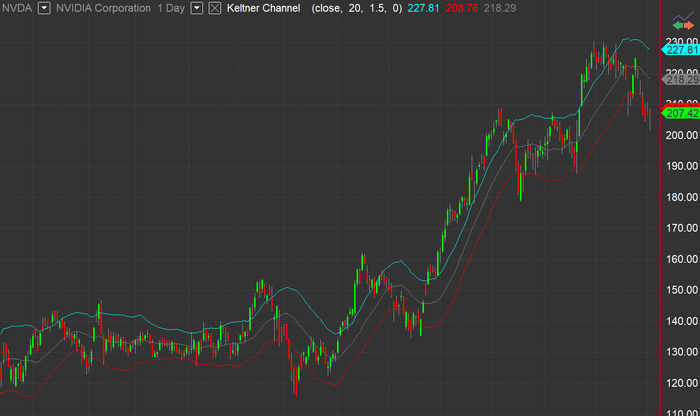Keltner Channel
Definition
The Keltner Channel indicator is a banded indicator similar to Bollinger Bands and Moving Average Envelopes. It consists of an Upper Envelope above a Middle Line as well as a Lower Envelope below the Middle Line. The Middle Line is a moving average of price over a user-defined time period. Either a simple moving average or an exponential moving average are typically used. The Upper and Lower Envelopes are set a (user-defined multiple) of a range away from the Middle Line. This can be a multiple of the daily high/low range, or more commonly a multiple of the Average True Range.
The basic idea behind the Keltner Channel was introduced by Chester Keltner in his 1960 book How to Make Money in Commodities.
Much like any indicator that is based around a moving average, The Keltner Channel indicator is a lagging indicator. Moving averages inherently lag behind the price and therefore so do any bands or envelopes that are calculated using a moving average. The main occurrences to look for when using Keltner Channel are breakthroughs above the Upper Envelope or below the Lower Envelope. A breakthrough above the Upper Envelope signifies overbought conditions. A breakthrough below the Lower Envelope signifies oversold conditions.
In terms of trend identification and determining overbought and oversold levels, the Keltner Channel indicator does this effectively. It is one of a number of banded indicators that accomplishes this task, just in its own way. While Keltner Channel can be used independently, it is best to use them with additional technical analysis tools. Historical analysis may also be helpful when trying to determine the correct parameters when setting up the indicator. Different securities may require a different multiplier to adjust the width of the bands or envelopes.
Default Inputs
Price sets what data from each bar will be used in calculations, close by default.
Length sets the time period to be used in calculating the MA which creates the base for the Upper and Lower Envelopes, 20 by default.
NumATRs sets a multiple of the average true range used, 1.5 by default.
Displace sets the number of bars to displace the plot, 0 by default.
